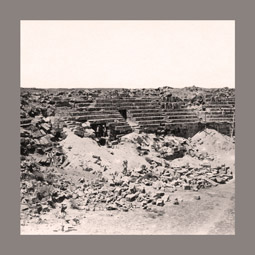scarica l’articolo in formato .pdf: L’anfiteatro di Sabratha: vecchie indagini e nuove ricerche
.
 L’Anfiteatro di Sabratha, ignorato dai viaggiatori del XVIII e XIX secolo, venne segnalato nel 1912 da Henri Méhier de Mathuisieulx ed indagato da Renato Bartoccini a partire dal 1924. Gli scavi e le ricerche portate avanti in quegli anni permisero di rimettere in luce gran parte del monumento, che rimase tuttavia non pubblicato. Recenti scavi e ricerche hanno adesso permesso di redigere un nuovo rilievo ed un nuovo studio del monumento. Il grande edificio, realizzato in conci di calcarenite locale, venne costruito sfruttando una cava di pietra alla periferia orientale della città antica probabilmente alla metà circa del II secolo d.C. e, contrariamente a quanto finora ritenuto, venne effettivamente completato, come testimonia l’esistenza di alcune cornici con i fori per il velarium. Impiega come unità di misura il cubito punico ed è possibile rintracciare anche lo schema geometrico proporzionale sotteso al progetto. Si stima potesse contenere circa 20-25.000 spettatori, un numero assai elevato in rapporto alla popolazione della città: il suo bacino di utenza era amplificato dalla vocazione mercantile dell’emporio e dalla periodica presenza delle carovane che trasportavano fin qui dal cuore dell’Africa Nera avorio, oro, animali e schiavi. Gli spettatori potevano assistere a grandiosi munera come quelli offerti da G. Flavio Pudente (IRT, 117). Probabilmente danneggiato da un sisma nel corso del IV secolo d.C., l’edificio venne abbandonato e spogliato quasi completamente nel VI secolo d.C.
L’Anfiteatro di Sabratha, ignorato dai viaggiatori del XVIII e XIX secolo, venne segnalato nel 1912 da Henri Méhier de Mathuisieulx ed indagato da Renato Bartoccini a partire dal 1924. Gli scavi e le ricerche portate avanti in quegli anni permisero di rimettere in luce gran parte del monumento, che rimase tuttavia non pubblicato. Recenti scavi e ricerche hanno adesso permesso di redigere un nuovo rilievo ed un nuovo studio del monumento. Il grande edificio, realizzato in conci di calcarenite locale, venne costruito sfruttando una cava di pietra alla periferia orientale della città antica probabilmente alla metà circa del II secolo d.C. e, contrariamente a quanto finora ritenuto, venne effettivamente completato, come testimonia l’esistenza di alcune cornici con i fori per il velarium. Impiega come unità di misura il cubito punico ed è possibile rintracciare anche lo schema geometrico proporzionale sotteso al progetto. Si stima potesse contenere circa 20-25.000 spettatori, un numero assai elevato in rapporto alla popolazione della città: il suo bacino di utenza era amplificato dalla vocazione mercantile dell’emporio e dalla periodica presenza delle carovane che trasportavano fin qui dal cuore dell’Africa Nera avorio, oro, animali e schiavi. Gli spettatori potevano assistere a grandiosi munera come quelli offerti da G. Flavio Pudente (IRT, 117). Probabilmente danneggiato da un sisma nel corso del IV secolo d.C., l’edificio venne abbandonato e spogliato quasi completamente nel VI secolo d.C.
.
The Amphitheatre of Sabratha, ignored by 18th and 19th century explorers, was described for the first time by Henri Méhier de Mathuisieulx in 1912 and investigated by Renato Bartoccini beginning in 1924. His work brought to light a large part of the monument, but it was not published. Recently, new research and excavations have made possible new topographical and architectonic drawings of the building, as well as new analysis. The Amphitheatre was completely constructed from local calcarenite blocks in the middle of the II Century A.D. and lies inside an ancient mine at the east boundary of the old site. Contrary to current opinion, it was completed as demonstrated by two blocks of the crowning cornice with holes for the poles of the velarium. The unit of measure used is the Punic cubit, and it is also possible to recognize the geometrical design of the project. Up to 20.000 spectators could be seated in its cavea, a very large number, given the population of the old town. This venue was capable of hosting large numbers of visitors who had come to Sabratha for the great feasts connected with a market that featured caravans of products transported from central Africa, including ivory, gold, animals and slaves. Spectators were able to see sumptuous munera such us that ones offered by G. Flavius Pudens (IRT, 117). The Amphitheatre may have been damaged by an earthquake during the 4th Century, after that it was abandoned and almost totally spoiled during the 6th Century.
